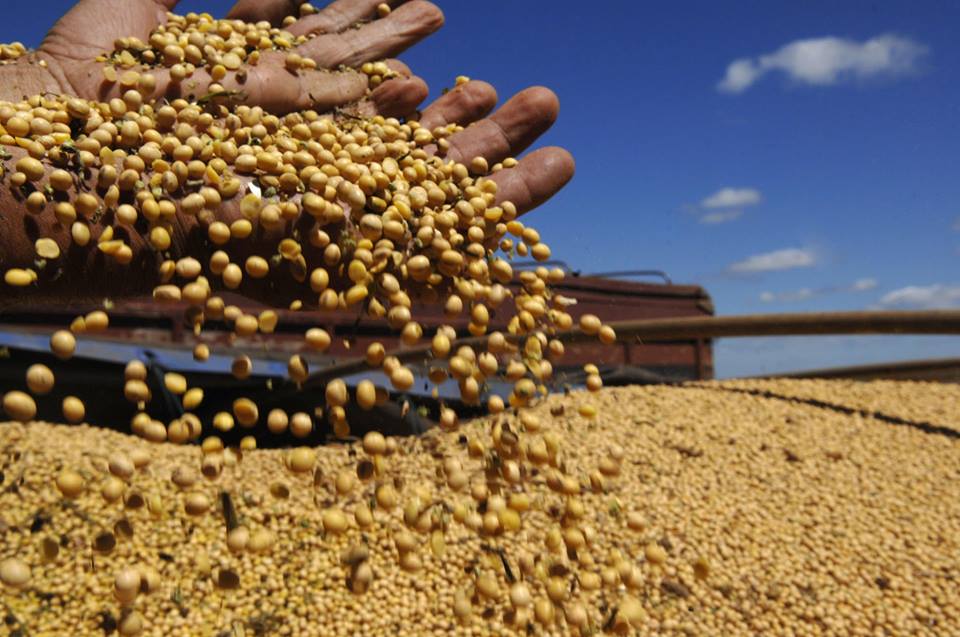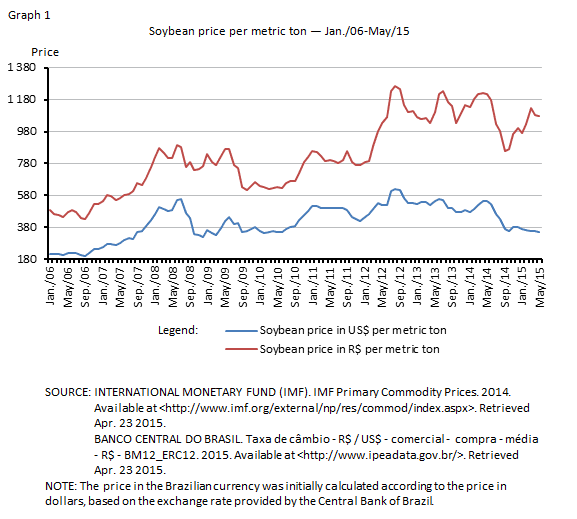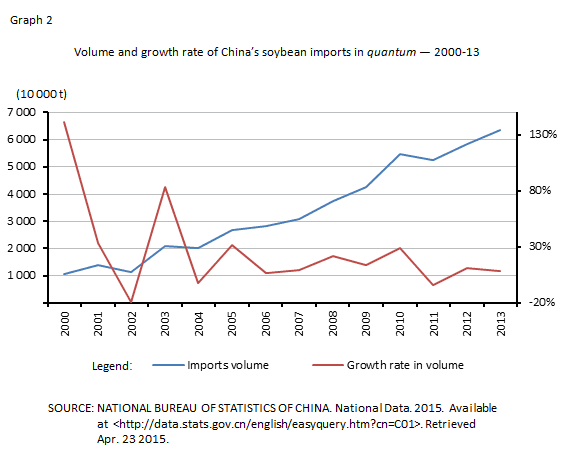Soybean exporting countries, such as Brazil, and the State of Rio Grande do Sul have benefited from the grain price increase in the international market in the last few years. Despite the fact that the currency appreciation caught up with the price rise in dollars between 2006 and 2011 — which damaged other exporting sectors, mainly the manufacturing one —, soybean prices, when converted to Brazilian Real, — went up, as we can see in Graph 1:
The price rise had a positive impact on national income, even though the policymakers and the local producers did not have influence over price formulation. Therefore, if the price is determined exogenously, it is important to study its movement in the international market and point out the possible events that are responsible for its path.
In order to do so, first we have to highlight the context in which soybean prices have hiked in the past few years. In the second half of 2006, soybean — such as the other agricultural commodities — entered an upward trend in its international prices started by metals and fuels in the mid-2003.
This recent boom in commodity prices is singular in terms of products range, duration and movement magnitude, according to the United Nations Conference on Trade and Development (UNCTAD) and the World Bank. This was the longest and most intense boom since the past century, and the only one that embraced simultaneously the three groups of commodities, agriculture, metals and fuels.
Soybean prices are inextricably related to that process. According to the data provided by the International Monetary Fund, the price, in dollars, of oilseeds was multiplied 2.65 times between April 2006 and July 2008, when it reached its peak until then. Soon after that, however, due to the world financial crisis triggered by the subprime market in the U.S., it suddenly slumped.
To many, this meant the end of the surge in prices, which could be categorized as a typical boom-bust dynamics. Notwithstanding, despite this abrupt drop, prices initiated a recovery cycle shortly afterwards, even before the world economy showed any signs of improvement after the crisis triggered by the downfall of the Lehman Brothers bank.
Hence, we cannot say that the 2008 financial crisis represented the end of this rising tide, as not only did soybean prices recover from the fall, but they also reached a new historic high in August 2012, which represented a 12.41% increase compared to the earlier apex. It is worth mentioning that, in the first semester of 2012, both the prices in U.S. dollars and the R$/US$ exchange rate rose, which allowed for a doubly positive performance regarding the valuation of the exports of this commodity to Brazil and to the State of Rio Grande do Sul.
From then on, soybean prices slowed down, but remained at a relatively stable level until 2014. However, a clear downward trend in the international prices arose in the late 2014, even though the value stood at a higher level in comparison to the initial years of growth — the soybean price in U.S. dollars in March 2015 was 72.14% greater than it was in April 2006. Besides, the exchange rate had a very important role in avoiding a more rapid fall in the Brazilian Real (actually there was a recovery in the Brazilian currency started in the third quarter of 2014, as can be seen in Graph 1).
Normally, the Chinese demand is pointed as the one and only determinant of soybean international prices. During the time they had a rising tendency, that is, from 2006 to the period before the 2008 financial crisis, the Chinese growth and its demand, mainly the one related to the production of swine feed, are the usual, simplistic explanation.
However, according to some World Bank reports, the soybean annual average consumption growth was higher in the period before the boom, that is, between 1997 and 2002 (5.8% in the world and 16.1% in China), than during the boom, from 2003 to 2008 (3.3% in the world and 8.7% in China).
During the international crisis, the Chinese demand did not seem to account for the sudden drop in prices, neither does it seem coherent to claim that it was responsible for the price recovery in the post-crisis period.
Given the circumstances, the UNCTAD attributed to the abrupt downfall and reversion movement in prices from 2008 to 2009 evidence of the influence of financial speculation on prices, as index investors in commodities future markets reduced their positions at the same time as price reduction took place. The investors withdrew their positions because they had to cover the financial losses caused by the crisis. They resumed their positions after the U.S. Federal Reserve System provided the banks with liquidity.
In the period after the soybean boom (2013-15), the slowdown in prices is generally associated with the slower growth of the Chinese Gross Domestic Product (GDP) and its commodity imports. ActuaIly, the Chinese soybean imports have dropped in value in the same way as the commodity prices have. However, we must bear in mind that the imports value is the multiplication of the quantity imported and its prices. Thus, if the price falls, the imports value also falls. That is why the most accurate way to address this issue is by analyzing quantity movements.
When we evaluate this indicator, we notice that the volume of the Chinese soybean imports slowed down after the boom, but this does not seem to be the only explanation, as Chinese soybean consumption kept slowing down after the beginning of the soybean boom, as Graph 2 shows:
In these circumstances, it is normal to question what other factors can impact on the soybean prices. Thus, in this sense, we can point out the American monetary policy, financial speculation and production costs. Among these factors, we can highlight the possible impact of oil prices on soybean prices. According to the World Bank, there is a synchronic relation between these two commodities when oil prices hit a mark between US$50 and US$60, and it is possible that this correlation exists because oil is the main component of the fertilizers used in soybean production. On the other hand, the Food and Agriculture Organization (FAO) has highlighted the role played by biofuels in this process.
For all these reasons, we cannot underestimate the complexity that characterizes the study of what determines soybean prices. The neglect of these possible determinants can catch by surprise the policymakers focused on giving a quick and simple response to a phenomenon that is more complex than we might think.



